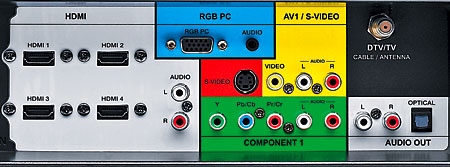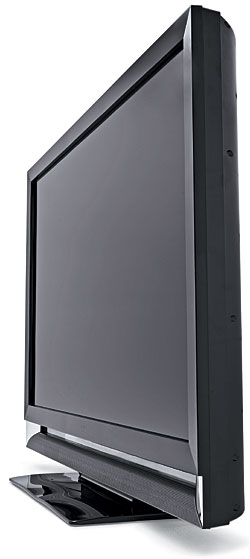Vizio VF550XVT LCD HDTV Page 2

There are several color-temp presets, but there’s no Warm preset as with most HDTVs. The Normal preset is closest to correct, but it tends slightly toward blue. This HDTV offers only one set of red, green, and blue calibration controls instead of two. I like to see a minimum of two sets of these controls (one for the top end of the brightness range and a second for the bottom end). One set is often insufficient to precisely dial in the gray scale.
 Fortunately, the color gamut was very close to accurate. This is great news, since the VF550XVT has no color management system that lets you adjust the color points.
Fortunately, the color gamut was very close to accurate. This is great news, since the VF550XVT has no color management system that lets you adjust the color points.
As I was taking white- and black-level measurements, it quickly became obvious that this set’s Achilles’ heel is its black level, which was relatively poor. As I discovered during my subsequent testing, it also exhibited better-than-usual off-axis performance. Personally, I prefer the other trade-off—better blacks and worse off-axis performance.
Moving on to my standard test discs, I started with the HQV Benchmark DVD at 480i via component. Jaggies were mild to moderate, and detail was OK but not great. On the plus side, the set’s noise reduction was quite effective without softening the image appreciably. Also, it picked up 3:2 pulldown instantly, although 2:2 video had lots of jaggies. Frame interpolation clearly sharpened the detail in any onscreen motion.
When I looked at the HQV Benchmark Blu-ray at 1080i via HDMI, the Strong noise-reduction setting softened the picture a bit, so I left it at Medium. Jaggies were invisible. Without frame interpolation, the movement in the film-based test was very juddery. When I turned on frame interpolation, the motion smoothed out considerably. However, there was some obvious smudging in finely detailed areas. I set Smooth Motion and Real Cinema to different values, but that didn’t seem to have much effect on the smudging.
Real-World Performance
First up in the real-world department was chapter 8 of Mission: Impossible III on Blu-ray at 1080i. The pan across the staircase pulsed with moderate moiré, and the shadow detail in the catacombs wasn’t great. The black level wasn’t great, either—the letterbox bars remained clearly in my consciousness. I set the backlight control to Mega DCR (Dynamic Contrast Ratio), and this lowered the blacks a bit, but it also made the entire picture duller. The OPC (Optimum Power Control) setting didn’t seem to do much at all, so I left this control in the Off position. The apparent black level rose as I moved off axis, but not as much as with many LCDs I’ve seen.
One great test of frame interpolation occurs near the beginning of Star Wars: Episode VI on DVD as Darth Vader’s shuttle approaches the Death Star. The first view of the Death Star from the shuttle cockpit was a bit shimmery in th e Smooth setting, as were the fine vertical lines on the wall of the landing bay as the shuttle approaches. Still, these artifacts were not nearly as bad as I’ve seen on some other 120-Hz LCDs. Otherwise, colors were excellent, and detail was as good as you’d expect from standard def. However, the black of space was not very deep, and lots of detail in the dark shuttle cockpit was lost.
e Smooth setting, as were the fine vertical lines on the wall of the landing bay as the shuttle approaches. Still, these artifacts were not nearly as bad as I’ve seen on some other 120-Hz LCDs. Otherwise, colors were excellent, and detail was as good as you’d expect from standard def. However, the black of space was not very deep, and lots of detail in the dark shuttle cockpit was lost.
Cars on Blu-ray has a moment that is particularly sensitive to frame-interpolation artifacts—it’s near the beginning when the three frontrunners in the race are being profiled. When it’s Lightning McQueen’s turn, he appears in an inset picture in front of an array of bright blue lights that exhibit any smudging artifacts that might arise from frame interpolation.
On the Vizio, the blue lights were indeed smudged, but not as blatantly as on many other LCDs I’ve seen. The Smooth setting caused more of this smudging than Precision, but it also smoothed out and sharpened the motion detail much more. I decided I could live with rare artifacts in the Smooth mode in order to enjoy much sharper and smoother motion otherwise.
When I prepared to play Cars on my Samsung BD-P1200 Blu-ray player, I tried to set it to output 1080p/24, but it would not let me select 24 fps. That was odd, so I set the Toshiba HD-XA2 HD DVD player to 1080p/24, but the Vizio’s screen went black, and I could not reset the player because I couldn’t see the menu. Outputting 1080p/60 worked fine in both cases. Vizio claims this issue with 1080p/24 was limited to earlier samples. If you run into this problem, Vizio will make a house call to fix it at no cost.
Blu-ray Discs looked superb in general, with excellent detail and color rendition. I really enjoyed Hidalgo’s beautiful skintones and textures, blue sky, colorful and intricate textiles, rock cliffs, and stone buildings. Shadow detail in the dark tents wasn’t that great. In fact, the picture seemed just a tad dull. But on the plus side, motion and pans were silky smooth in Smooth mode, almost like 1080p/24.
Fantastic Four: Rise of the Silver Surfer on Blu-ray was about the same. The opening shots in space were pretty dull, but the moving titles and credits were smooth and sharp. Bright scenes were nice and punchy, detail in things like cityscapes was excellent, and colors were right on the money. As before, shadow detail in Von Doom’s lair was only so-so.
Master and Commander: The Far Side of the World on DVD is a great test of shadow detail. As I expected, the Vizio didn’t perform well in this regard. The many fog-bound shots were rather dull, but the image popped much more in the bright sunlight when the ship arrives at the Galapagos Islands. Detail was pretty good for a DVD, and the colors were spot on.
The audio level was very low in general, and turning SRS TruVolume on helped a lot. SRS TruSurround HD didn’t seem to do much except affect the tone, and not in a way that helped the dull sound. The audio controls include a five-band EQ, which wasn’t much help either—the bands are too wide to be of much use. Even a modest HTIB would improve the audio experience greatly.
Comparisons and Conclusion
The most comparable LCD HDTVs I’ve reviewed lately include the Westinghouse TX-52F480S ($2,500), Sharp LC-52D85U ($2,600), and Toshiba 52XV545U ($2,600, HT, March 2009). All of these are smaller and more expensive than the Vizio.
The Westinghouse has excellent color and detail, and a somewhat lower black level, but its motion detail is lacking because of its 60-Hz refresh rate. The Sharp’s black level and shadow detail are comparable to the Vizio’s, its color is excellent, and its 120-Hz frame interpolation is very mild mannered. This means there are no visible artifacts, but it also means the motion detail is not as sharp as on the Vizio. The Toshiba offers a better black level, and its SRT upconversion technology offers the best standard-def performance of any of these sets, but its colors are not nearly as accurate.
Which would I choose? On balance, it would have to be the Vizio. But if I could afford $900 more, I’d go for the Samsung LN52A750, which has a much lower black level, better shadow detail, excellent processing, accurate colors, and USB and Ethernet connectivity.
Still, at $2,000, the VF550XVT offers the best bang for the buck I’ve seen in LCD HDTVs. If money is tight for you—as it is for most folks these days—it’s a good deal that’s worth serious consideration.





























































